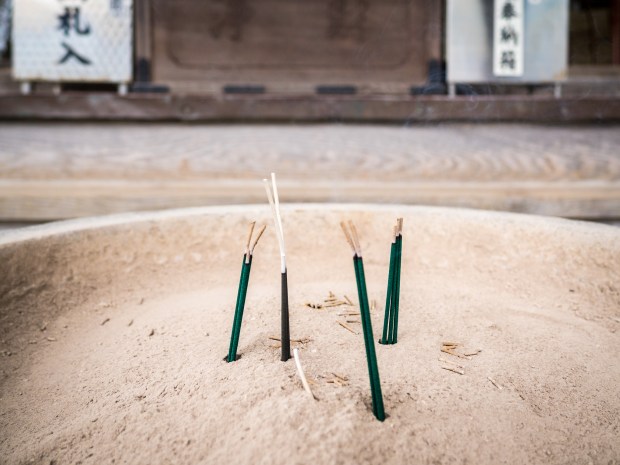Signs lead us to the sea.
The day starts early with a visit to Temple 22, Byōdōji, conveniently located beside Sazanka, last night’s ryokan. As at most temples Kongō Rikishi statues guard the entrance to the temple. The figures are fierce protectors of the faith complete with snakes wrapped around their well-tooled chests. Not far down the road, the serpent imagery reappears on a handmade sign with a playful snake wriggling across the painted wood surface. It has an endearing child-like quality that belies its message of impending doom.
The Shikoku snakes are neither cute like this nor mythological like those those of the Kongō Rikishi statues. They are very real and very poisonous. There are two varieties of which to be wary. The Yamatagashi is relatively innocent, poisonous yet timid and rarely in the biting mood. More serious is the mamushi, a small pit viper whose bite will result in a week’s visit to the hospital or, for about ten unlucky souls each year, a trip to the cemetery.
Today’s hazards don’t prove venomous. More trecherous, as our route follows the busy Highway 55 and takes us through tight tunnels with only a thin white line painted on the road separating us from speeding trucks.
Quirky signs dot the trail as we continue to the coast. Little Henro sculptures appear here and there. Yellow traffic signs warning of…crabs crossing! Soon we are on the quieter Highway 26. In a landscape still dominated by forests and mountains, a new kind of ‘sign’ appears. Here in this decidedly non-aquatic setting we stumble across a fine storefront display of surfboards. It’s a prelude to the sea that greets us just a few kilometers further on.
It’s fall now and the beaches that would be bustling during the summer months are all but deserted. The North Pacific is likewise quiet today. But, like a snake quietly resting in the distance, the Pacific can also strike suddenly. Now a new sign makes its first appearance. A green square, a curled wave, a running figure, a steep climb. This is the icon that will appear at almost every turn as we journey along the coastline. It is the sign for a tsunami evacuation route. It guides residents and tourists to higher ground in hopes of surviving a wave that, in worst-case modeling studies, could exceed 100 feet in height.
Our route continues down the coast, past the dormant tourist village at Tainohama Beach and on to Hiwasa, our destination for the night. Creeping up the mountains that lie just behind the town is Temple 23, Yakuōji. Despite its urban setting, it is a peaceful space. The grounds are engulfed in a tangle of trees, their spare limbs artfully entwined with the temple’s buildings and statues.
For a change of pace, we stay at Cairns Hotel, a typical ‘business hotel’ offering western-style rooms and no Japanese-style baths or meals. So we head off to Hikainoyado Ikko, an onsen with attached restaurant. It is a luxurious way to end the day, first with a long, restorative soak in the the hot and cold baths and then a meal of finely-marbled Wagyu beef.






























Gorgeous photographs David and I love the one of your dinner!